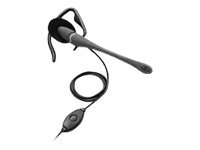
A detailed list of technical data, specifications, ratings and expert review of Poly - Plantronics M 133-N3. Get a comprehensive look at your chosen headphones and see if these are the ones that will best suit your needs. You can also use the comparison feature to compare with other competing headphones.
design and dimensions sound quality microphone remote control cable connections
| DESIGN AND DIMENSIONS Poly - Plantronics M 133-N3 |
|---|
| Product Type | Headset - wired | |
|---|---|---|
| Colour | Blue | |
| Recommended Use | Portable electronics |
The Poly - Plantronics M 133-N3 are wired headphones. In the case of studio and professional DJ headphones, a wired connection is a standard and a necessity. In this case, connecting via cable reduces audio transmission delays and prevents unwanted battery drain as it would be in case of wireless headphones. The same is de facto true for gaming headsets. In case of headphones for normal music listening, the cable is rather a relic, although it still has its fans. However, the wireless option is much more popular for everyday use in today’s world.
Show more| SOUND QUALITY Poly - Plantronics M 133-N3 |
|---|
| Headphones Form Factor | Over-the-ear mount | |
|---|---|---|
| Headphones Technology | Dynamic | |
| Connectivity Technology | Wired | |
| Sound Output Mode | Mono | |
| Frequency Response | 300 - 3300 Hz | Worse than 98 % of in-ear headphones rated. |
| Total Harmonic Distortion (THD) | 5% | |
| Impedance | 32 Ohm |
The sound quality can be affected by many factors. For many users the frequency range is a key feature of headphones. The wider the range, the more detail and nuance you will hear while listening. However, every individual perceives frequencies differently, so the frequency range of headphones varies according to individual needs. The average person perceives frequencies in the range of 16 to 20,000 Hz, so headphones with a frequency range of 20 to 20,000 Hz are most commonly available. If you are looking for headphones with a good bass performance, you should aim for lower range values (bass represents frequencies up to about 256 Hz), while high range values (frequencies roughly above 2,048 Hz) will be better for reproducing high tones. The frequency range of headphones Poly - Plantronics M 133-N3 is 300 - 3300 Hz.
The device connected to the headphones also plays a role most times. The lower impedance value (approximately 100 to 150 Ohms) is suitable for playback from mobile phones, laptops or other portable players that do not have a powerful enough amplifier. The lower impedance will ensure that the required volume level is achieved with less power, thus extending the life of the player. However, at the same time, with lower impedance, there is more distortion of the sound. Headphones with a higher impedance of around 250 Ohms and above are then more suitable for playback from really powerful signal sources or using a headphone amplifier, otherwise the sound coming out of them might not be loud enough. At the same time, higher-impedance headphones will also ensure less distortion in the sound. In the case of these headphones, the impedance reaches the 32 Ohm value. Total Harmonic Distortion of these headphones is Audio Output | Total Harmonic Distortion. The value quoted by the manufacturer is usually the average distortion over all reproducible frequency bands. This is not a crucial parameter to decide on when making a decision, but on the other hand, keep in mind that higher harmonic distortion can negatively affect sound quality.
| MICROPHONE Poly - Plantronics M 133-N3 |
|---|
| Type | Boom | |
|---|---|---|
| Microphone Operation Mode | Mono, cardioid | |
| Frequency Response | 300 - 3300 Hz | Worse than 89 % of in-ear headphones rated. |
| Total Harmonic Distortion (THD) | 5% | Better than 81 % of in-ear headphones rated. |
| Sensitivity | -50 dBV/Pascal | |
| Impedance | 3.3 kOhm | |
| Microphone Power Source Voltage (DC) | 3 V |
Poly - Plantronics M 133-N3 has a boom–type microphone. The microphone sensitivity is -50 dBV/Pascal. A lower microphone sensitivity will generally ensure that even quieter sounds are caught. On the other hand, in noisier environments, distortion of the recording may occur. With a higher sensitivity, the microphone will not distort the recording even in noisy environments. On the other hand, the microphone will not pick up quieter sounds. So it depends on the environment and the purposes you plan to use the headphones for. As with headphones, so-called harmonic distortion affects the sound quality of a microphone. Harmonic distortion above 5% is quite high and can lead to a reduction in recording quality. The average for most headphones is a distortion between 1 and 5%. For the average user, the recording quality of a headphone microphone in this interval should be perfectly adequate. Total harmonic distortion below 1% is more likely to be encountered in professional headphones. Such distortion is already considered very low and will ensure maximum recording quality. The total harmonic distortion of this microphone model is Microphone | Total Harmonic Distortion.
Show more| REMOTE CONTROL Poly - Plantronics M 133-N3 |
|---|
| Controls | Answer/end |
|---|
| CABLE Poly - Plantronics M 133-N3 |
|---|
| Cable Type | Headset cable - 1.2 m |
|---|
| CONNECTIONS Poly - Plantronics M 133-N3 |
|---|
| Connector Type | Headset (cellular phone connector) |
|---|
Similar Headphones
Other Plantronics Headphones